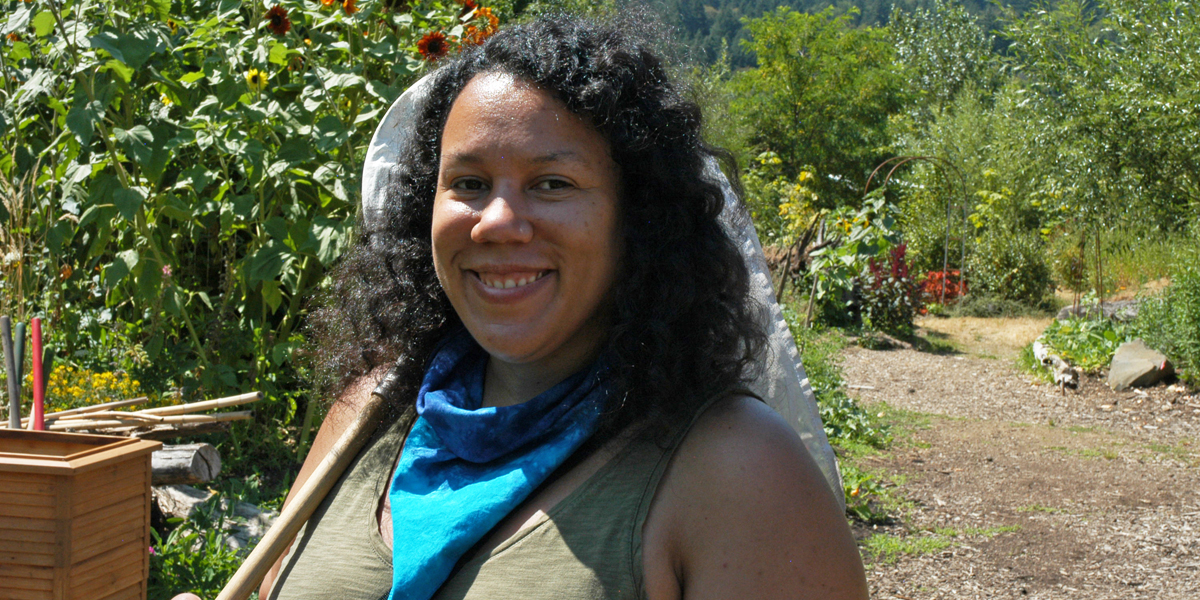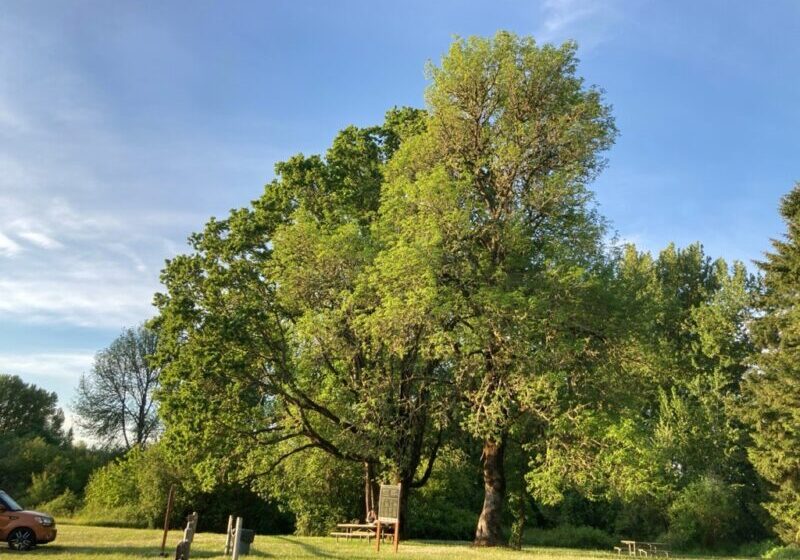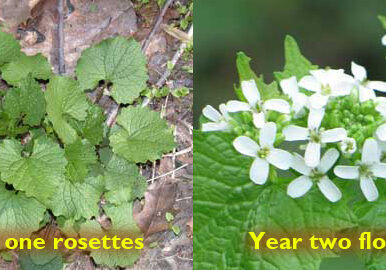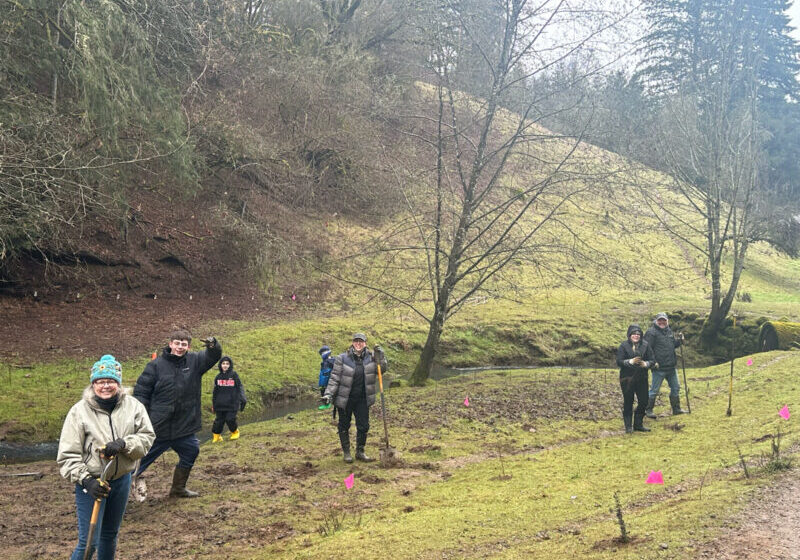If you were to guess how many species of native bees there are in Portland, how many would that be? And where do these bees prefer to nest? Local emerging entomologist, Stefanie Steele, a Master’s student at Portland State University (PSU) studying native bees in the Portland area, is working to answer those questions.
At the garden at Green Anchors in North Portland, one of her research sites, Steele slowly makes her way among the abundant flowering plants, inspecting them for tiny buzzing pollinators. A quick flick of her insect net captures a long horned bee (which turns out to be Melissodes sp., an Asteraceae plant specialist) that she carefully navigates into a clear plastic vial for safe transport back to the lab for identification.
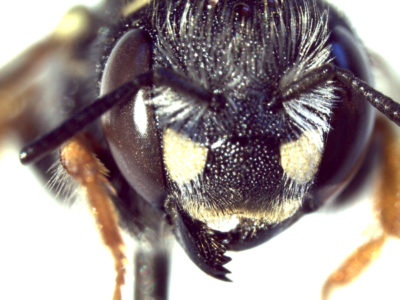
“It’s very hard to identify them in the field,” says Steele. “You need a microscope to look at very small morphological features such as the venation on their wings – maybe they have two or three submarginal cells, or if specific veins are curved or arched. Or other very small details, like the size and density of the punctures on their integument (the “skin” on the abdomen) or counting the number of teeth on the mandible.”
It all started with honeybees
Steele’s interest in bees began at a young age when she was part of her school’s bee club which kept several honeybee hives on the school roof. “Have you ever been inside a honeybee hive?” asks Steele. “I recommend it to everyone. It’s a full immersive experience, seeing all the bees walking around, seeing how they’re communicating with each other, even the smell of it and the sound of them. It’s a really, really cool experience. And they work together cooperatively so well. Their whole social system is really amazing and intriguing to see. That’s what got me hooked.”
Steele moved to Portland to try out a different location after two years at the University of Cincinnati. Like many others, she was drawn to all the different natural environments in Oregon. She went back to school at PSU to finish her bachelors in biology and during that time was inspired to start the Bee Task Force (scroll down on page linked here to find the Bee Task Force) with help from other students and faculty. The Task Force was focused on maintaining honeybee hives and creating pollinator habitat for the honeybees and for native bees in that area. It was through this work that Steele met Susan Masta, PSU Associate Professor and head of the Masta Lab where Steele’s graduate work is now based, and where her research expanded to native bees.
Portland bee survey
Bee collection and identification are key components of a 3-year survey of bees in urban Portland that Steele developed as an undergraduate with Masta. Before this project, no one else in the Portland area had published a survey to determine what native bee species reside in our area, as bees on the west coast are far understudied. They are looking to discover what bees are found here, when they are active, and also what their floral and other plant associations are – which plants and flowers they use for nectar, pollen, nesting materials, or nesting sites.
Through the Portland bee survey, Steele, Masta and team have so far found over 100 species of bees in urban Portland. The survey team is still working to identify the species they collected, and as they learn more, they expect those numbers to increase. The next step will be to publish the results of the first three years of the survey. Future research may depend on available funding and staffing to collect and identify new specimens.
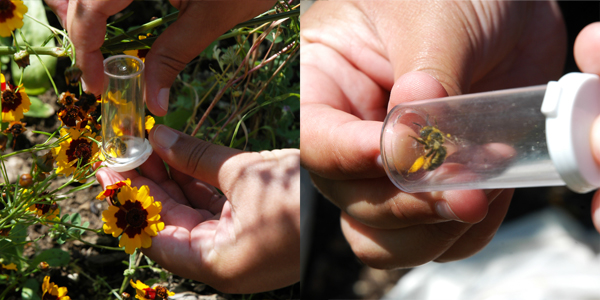
One challenge that Steele and colleagues face with identification is the lack of a comprehensive species list to reference for Oregon. “There is still so much to be learned about the bees of Oregon,” Steele explains. “We’re still working on identification in general within the U.S., but the east coast overall is well studied. The west coast is far less studied, so a lot of the morphological cues that we’re using to identify the bees comes from the east. There is some overlap within species, but they aren’t all entirely the same.”
Steele is helping to grow that state-wide knowledge. Some of the species she has collected will be housed within the invertebrate collection at the Portland State Museum of Natural History where they can be used for education, research, or historical state records.
Native bee nesting research
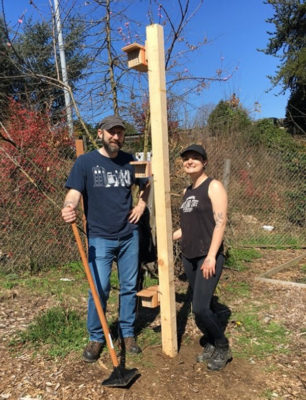
Steele’s graduate work with Susan Masta grew out of the Portland bee survey. Steele is focused on investigating the nesting height and diameter preferences of solitary cavity nesting bees. Her research is sited at 14 locations around the city including Green Anchors, the PSU campus and community orchard, and friends’ and colleagues’ homes that have gardens designed to attract pollinators. She erected posts with 54 wood nesting boxes set at 3 different heights, each with trays that had 31 cavities of varying diameters ranging from 3 to 10 millimeters.
Volunteers helped monitor the boxes throughout the nesting season, recording which of the cavities contained nesting material, adult bees, or wasps that also nest in cavities. Once nesting activities were complete, Steele collected the boxes for incubation in the lab. Overall, her nests had good occupancy rates—about 28% and successful incubation reared fifteen species of bees. She did see some loss of specimens due to mold that may have developed because of weather at the end of the nesting season or was introduced by the female bee. “The adult bee may inadvertently collect pollen that has mold spores on it,” Steele explains. “As she moves throughout the cavity, building separate cells for each egg, she can distribute those mold spores throughout the entire nest.”
During incubation, Steele also saw some parasitism, which can be a sign of a healthy ecosystem. In some of her nest trays, tiny wasps (likely Melittobia) or the bee fly mimic (Anthrax) had infiltrated the nesting cells while still in the field and laid their eggs on top of the bee eggs. The larvae of these parasitoid insects feed on the larva of a host bee or wasp, eventually killing it. In one case, an undergraduate assistant counted 80 of the 1-millimeter wasps parasitizing one bee larva. Steele comments, “Just imagine all of these wasps completing their development and then moving on to the next developing bees. Crazy.”
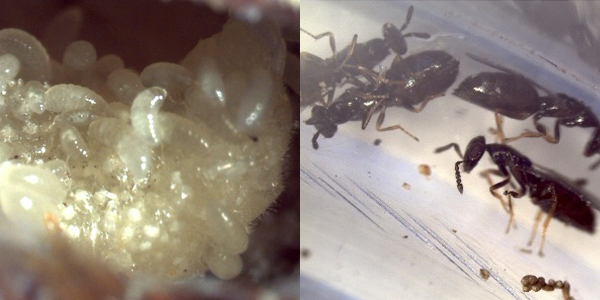
Awaiting results
Aside from these losses, Steele’s research, timeline, and goals stayed on the course she had set initially. She is currently analyzing the massive amount of field data she and her volunteers collected. One early takeaway that the research confirmed is the importance of available cavity nesting habitat. Bees only get a short window as an adult to find suitable nesting sites to create the next generation of bees. “Most of a bee’s life is spent in diapause when they’re essentially inactive and at a more vulnerable state as a larva – about ten or eleven months out of the year,” Steele says. “And then for four to six to eight weeks, they’re active flying adults.”
Yard features that are sometimes considered unattractive, like dead leaves and logs on the ground, dead tree limbs, or even entire snags – standing dead trees – actually provide important bee habitat. “Beetle larvae will excavate tunnels in downed logs or standing dead trees, and when the beetles are gone a bee will find that unoccupied cavity, and that is prime habitat,” explains Steele. Deadheaded hollow or pithy stemmed plants are also great habitat. “Some bees, like small carpenter bees in the genus Ceratina, will chew out the pithy stemmed plants and then nest inside,” she says.
“About 70 percent of bee species nest in the ground,” says Steele, “but 30 percent nest in cavities, and with all that perpetual yard tidying, nesting habitat is severely limited. So, you could change your habits, but you could also provide artificial nesting structures.”
For gardeners looking to provide nesting structures, offering a variety of cavity hole sizes is important, especially smaller holes. In Steele’s study, the 3 and 5 millimeter diameter holes were used most. “The female bee wants to ensure a tight fit to reduce moisture and parasitism and still allow space she needs to lay eggs and fertilize some of them,” says Steele. She found that a greater number of smaller rather than larger bodied bees occupied the nests she put out. “Osmia lignaria is the mason bee that a lot of people are familiar with. They are a little bit smaller than a honeybee. I found them nesting in the five millimeter size, six millimeter size, and the eight millimeter size cavities. So if you provide a diversity of sizes, then greater numbers of bees would be able to utilize those spaces.”
Placement of cavities is also important to consider. Facing holes southeast is ideal to catch some heat from the morning sun, and prevent overheating as south-facing holes may experience. Boxes should be sheltered and angled slightly downward to prevent rain from getting inside. Steele also recommends providing a selection of plants and flowers that will bloom throughout the growing season. “There’s less floral nectar available at the end of summer season into fall, so providing more forage for them throughout the entire season is very important,” she says. (See our Pollinator Plants & Bloom Periods chart for guidance.)
Communities in science and nature
Steele’s own community plays an important role in her research. The Oregon Bee Atlas designed and donated 30 of the 54 nest boxes, and are also leading a state wide survey effort of the bees of Oregon. Steele also found help from woodworkers at Green Anchors with the proper tools to build the remaining boxes. Her volunteer monitors were also essential for helping collect data.
The greater scientific community however, has presented a challenge for Steele. She is often one of the only BIPOC at a workshop or conference in her field, and she finds it discouraging and uncomfortable at times. However, she feels fortunate for the colleagues, mentors, and advisors in her life that encourage and elevate her. She also finds joy in engaging young people in the fascinating world of bees, and showing them that she too is what an entomologist looks like, a woman of color. Steele looks forward to connecting with more BIPOC in her field and related fields.
Steele also hopes her research will help inform gardeners and others looking to support our local native bee populations with information on suitable habitat and how to make outdoor spaces more attractive to cavity nesting bees.
For more information and project updates contact Stefanie Steele, steelestk@gmail.com.
For information on pollinator research completed by West Multnomah Soil & Water Conservation District, see our Pollinator Monitoring Community Science Program page.
